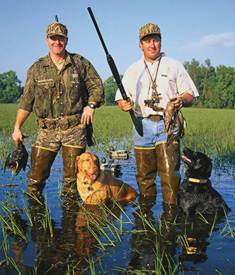|
Teal Time
Fast shooting for fastflying bluewings provides a great early-season
option for the Texas waterfowling fraternity
By Larry Bozka
Page 2
|

The hard-earned payoff for pre-season planning and preparation:
Troy Coleman (left) and Will Beaty of Central Flyway Outfitters in Winnie boast
a 90-percent-plus success rate for limited-out teal hunts. Thanks
to the pair's highly trained retrievers--Amber, Coleman's yellow lab, and Dixie,
Beaty's black lab--lost birds are all but nonexistent. Watching dogs like
these perform is a wonderful aspect of the overall hunting experience.
|
Team CFO is sponsored by Gene Anderson, owner of Gene's Polaris
Country in Dayton (1-800-544-0694). Take it from someone who has
death-marched through one too many miles of grueling, water-saturated
blackland gumbo; a powerful ATV like the Polaris 425 4-Stroke
Magnum allows you to focus on excitement instead of exhaustion.
"It gives us the ability to drive our customers right to
the blind," says Beaty, "and it takes the physical deterrent
out of the duck-hunting formula." Beaty, Coleman and crew
rely on a fleet of 12 to 15 Polaris 6-wheelers and 4-wheelers;
each guide runs his own. "In most of our spots you can hunt
with your tennis shoes on," Beaty says, "although I
still recommend that you wear hip boots just to be safe."
"We also use professionally-trained dogs," Coleman
adds. "Early on, when you're hunting a freshly-flooded area,
downed birds can be surprisingly tough to find. A good retriever
eliminates any waste of the resource and adds a whole lot to the
overall hunting experience."
It certainly does. I spend a lot of time hunting with these guys,
and along with their friendship and top-notch hunting, really
treasure the experience of watching their dogs at work. Coleman's
yellow lab Amber and Beaty's black lab Dixie, both 6 years old,
become poetry in action when the guns go off. Observing and photographing
the dogs, at least for me, is every bit as enthralling as gauging
the lead on an incoming bluewing.
And believe me; you *do* need to gauge the amount of lead-the
distance you put between the bird's head and your shot string.
Teal rival mourning doves in their speed and aerobatic prowess,
and only a foolhardy hunter or a world-class wingshot expects
them to be easy targets.
Invariably, you're a lot better off shooting "too far ahead"
when gunning for teal. It doesn't take but a few pellets in the
head to put one down. And when it comes time to eat the birds-and
teal are *excellent* table fare-it's nice to bite into a smoked
duck breast that isn't riddled with steel shot. The rock-hard
pellets are a dentist's dream-come-true.
Twelve-gauge shotguns with improved-cylinder chokes are standard.
A 20-gauge-preferably in 3-inch magnum-will also get the job done.
As for shells, stick with No. 6 or No. 4 steel. This morning,
Coleman and I experimented with Federal's new tungsten steel,
and found out fast that the stuff is deadly. Several birds that
had been hit too far back and were veering out of range-I'm talking
50 to 60 yards-were slam-dunked when we sent a load of No. 2
tungsten their way.
Federal's new No. 4 tungsten loads are now available, and I can't
wait to give 'em a try. Just because teal are little doesn't mean
they're not tough, and I love the edge that the hard-hitting tungsten
shot affords the shooter. For big, wary snow geese, that edge
is even more pronounced. Tungsten costs considerably more than
steel, but in my estimation-as well as from a conservation standpoint-the
performance is well worth the price.
As for calling, it's the same concept as with most any other
species of waterfowl. Call to turn the birds; then put a lid on
it.
"You use your call to position the birds," Beaty reiterates.
"Aside from the standard 'teal whistle' that imitates the
peeping sound of a teal hen on the water, we also use a Sure-Shot
mallard call to create a screeching, 4- or 5-syllable 'highball'
sound that turns the birds around. Once they turn," he stresses,
"you stop. Drop the call and get ready to shoot." Which
we do, as one last flock of bluewings buzzes the decoy block and
settles into the open, watery pocket.
Suffice it to say I'll have to get even with those birds later
this month.
(Note: CFO's early-season teal hunting packages provide the essence
of variety. Given access to so much pre-scouted terrain, hunters
often opt for a one-day "combo" shoot-teal in the morning,
doves in the evening. Or, for a bona fide marshland adventure
(and the raw material for a fancy pair of cowboy boots), you might
try alligator hunting with CFO lodge manager Harlan "Gator"
Hatcher. Six-feet-five and 240 pounds of solid muscle, Hatcher-who
handles alligator "nuisance control" for Chambers County-
has been known to carry dispatched 8-foot-long, 300-pound-plus
'gators over his shoulders. "We can videotape your hunt,
process the meat and even have your boots made," notes Beaty.
If that isn't enough, Troy Coleman-make that Capt. Troy Coleman-can
also take you on an afternoon trout and redfish expedition to
nearby Trinity Bay. For more information on these hunts as well
as the upcoming duck and goose season, call Will Beaty at 409-826-4490
or page him at 281-262-2378 . Capt. Troy Coleman can be reached
at 281-359-5820; his pager number is 1-800-631-3731. Write to:
Central Flyway Outfitters, Inc., P.O. Box 5791, Kingwood, TX
77325-5791. Or, check out the CFO website at: http://www.hunttexas.com)
# # # #
page 1 / page 2
|

